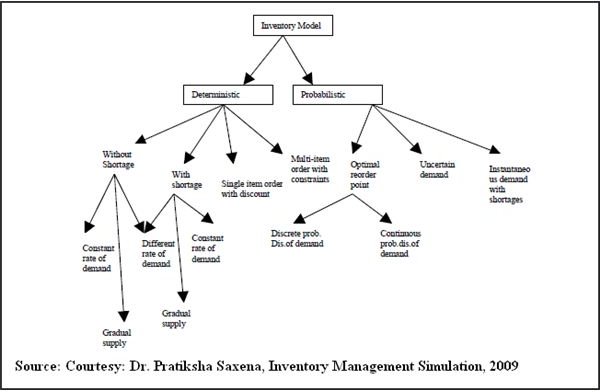Deterministic and Probabilistic Methods of Inventory Control
Introduction
Inventory is classified as idle possessions that possess economic value but still it is very essential to maintain inventory for different kind of manufacturing units, retailers, factories and enterprises. Generally, it is a vital constituent of the investment collection of any generative organization. Approximately up to 60% of the yearly production budget is used up on material and other inventories. It cannot be overstressed that better inventory management would constantly develop organizational productivity, decrease costs, and contribute to responsible use of scarce capital.
Other than raw materials, other forms of inventory include in-process, supplies, components, and finished goods inventory. The most important aim of inventory management is to decide how much resources or inputs are to be arranged and when to order so as to reduce production cost, while conforming to the essential requirements.
Due to ranging abnormality of the production inventory, no specific inventory model has general relevance to the whole variant inventory situations. As a result, a range of inventory models have appeared which address specific inventory problems.
Deterministic and Probabilistic Methods
The classic inventory model is generally used either to forecast optimum inventory or to evaluate two or more inventory systems. Two fundamental techniques are generally employed by industries to develop inventory reserve estimates and they are the deterministic and probabilistic methods. The deterministic method concedes a single best estimation of inventory reserves grounded on recognized engineering, geological, and economic information. The probabilistic method employs the known economic, geologica,l and engineering data to produce a collection of approximate stock reserve quantities and their related probabilities. Each inventory reserve categorization gives a signal of the prospect of revival.
The advantage of a probabilistic approach lies in the fact that by using values lying within a bandwidth and modeled by a defined distribution density, the reality can be modeled better than by using deterministic figures.
Deterministic models of inventory control are used to determine the optimal inventory of a single item when demand is mostly largely obscure. Under this model inventory is built up at a constant rate to meet a determined, or accepted, demand. For instance a contract is received in January for 100 model trains and the delivery to be completed by November/holiday shopping. Since the deadline is 10 months so the trains can be produced at a rate of ten per month.
Also stochastic one-item models can be used for inventory control. Such models are used when demand is not known. Stochastic models are more realistic, and thus more relevant, since they regard the cost of shortfalls, the cost of arranging and the cost of stacking away, and attempt to formulate an optimal inventory plan.
What is Deterministic and Probabilistic inventory control?
To value it better, let us imagine deterministic and probabilistic conditions.
A deterministic circumstance is one in which the system parameters can be ascertained precisely. This is also known as a situation of sureness since it is realized that whatever are ascertained, things are sure to occur the same way. Also the information about the system under thought should be whole so that the parameters can be determined with confidence. But this kind of system rarely exists, and it is for sure that some uncertainty is always associated with the system.
Deterministic optimization models presume the state of affairs to be deterministic and consequently render the numerical model to optimize on system arguments. Since it conceives the system to be deterministic, it automatically means that one has full information about the system.
Probabilistic situation is also known as a situation of uncertainty. Although this is present everywhere, the vagueness always makes us comfortless. So people keep attempting to lessen uncertainty.
Probabilistic inventory prototypes consisting of probabilistic demand and supply are more suitable in many real circumstances. But, such models also create larger trouble in analysis and often become uncontrollable.
Conclusion
Thus we can conclude by stating that the best inventory plan, in most cases, will be to minimize the cost of holding stock of raw-materials or finished products. Whether to choose deterministic or probabilistic models of inventory control will depend on the type of the industry.
Books referred:
Economic order quantities with inflation, Operation Research by Buzacott, J.A., 1975.
Integrated Materials Management; A Functional Approach by Datta, A.K., 1989.
Principles of Operations Research by Harvey, M.W., 1987.
https://www.medwelljournals.com/fulltext/?doi=ibm.2009.75.79
